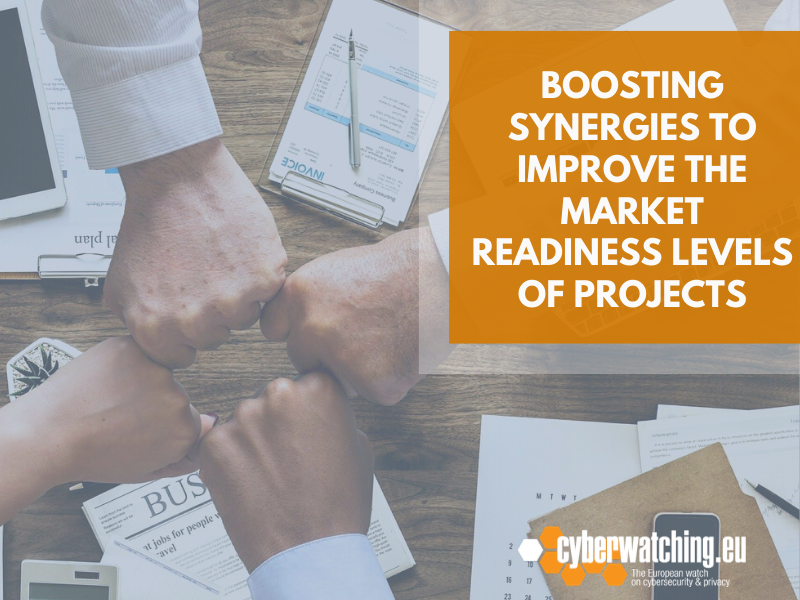
Boosting synergies to improve the market readiness levels of projects

One of the goals of the Cyberwatching.eu project is to identify ways to cluster active projects with similar aims for their mutual benefit, identifying possible opportunities for lightweight synergies and supporting them with targeted support activities, such as joint webinars and outreach activities.
In order to achieve this objective, in the past weeks Cyberwatching.eu organised two virtual meetings with two different groups of projects, with the specific aim to help them improve their market capabilities.
The clusters have been created according to similarity of projects in their Marketing Readiness Level (MRL) at this point of their execution.
The meetings included some key speakers, such as Georgios Lyssandredis and Ada Matei, from the Common Competence Centre at DG RTD, who presented the Horizon Results Platform; Michel Drescher, from Oxford University, who showcased the new project radar and asked projects to test the new features; and Nicholas Ferguson, Cyberwatching.eu coordinator, who introduced the marketplace and the new Horizon Results Booster service.
During the second part of the meetings, Marina Ramírez, from AEI Ciberseguridad, explained which are the commonalities of the projects joining the meetings and opened the debate.
In the first virtual meeting, which took place on the 9th of July 2020 and involved 7 active R&I projects with an MRL score of between 3 and 4 (FENTEC, SealedGRID, PAPAYA, DEFEND, PANACEA, GUARD and SAPPAN), some starting points for collaboration emerged. One of them is the joint organisation of webinars focusing on three sectors:
- Healthcare: the theme was proposed by PANACEA with the aim to raise awareness of cybersecurity among hospital and public sector managers. The idea was supported by DEFEND and by SAPPAN.
- Energy: the theme was proposed by SealedGRID, which is oriented towards digital infrastructure and government and public authorities in the energy sector. The topic raised interest in the SAPPAN and DEFEND projects.
- Financial: the theme was proposed by FENTEC, which is working with Functional Encryption that can be applied to digital currency, motion detection, and stat analysis. This target sector raised lower interest compared to the previous two among projects joining the meeting.
During the second cluster meeting, which took place on the 16th of July 2020 and involved a group of projects with an MRL score of 5-6-7 (CS-AWARE, STOP-IT, PoSeIDon, CyberSec4Europe, ECHO, SecureIoT, SECREDAS, InfraStress, EnergyShield and CARAMEL), a variety of thematic areas was discussed.
- Threat intelligence and Information sharing: the theme was proposed by ECHO, which is organising a table top exercise that will take place in October and will engage 20-25 organisations for incidents management, early warning and information sharing. The topic was welcomed by Cybersec4Europe, which is working on it in the context of banking with CONCORDIA. The CARAMEL project also showed some interest in information sharing for connected vehicles since the European Commission is putting great emphasis on data sharing in and out the vehicles. SECREDAS deals with the same field area (vehicles) and, during the meeting, proposed creating a larger group of interest and participating in a collaborative meeting.
- Local Public Administration: Cybersec4Europe and CS-AWARE, which is ending in August, are interested in organising a webinar or a workshop to engage public organisations and the two projects agreed to have a parallel discussion about this. CS-AWARE suggested the creation of a restrictive discussion group, including national organisations, focusing on COVID19 medium- and long-term impact on PA and its digitalsation process.
- Finance/banking: CS-AWARE aims to commercialise the Cybersecurity Awareness Solution for Local Public Administrations they developed within the project, and for this reason they are interested in creating synergies with partners working on the same topic, in order to find complementary solutions to reach the market.
Cyberwatching offered support in the organisation, hosting and promotion of public webinars involving the projects clustered according to their target sectors. Cyberwatching also proposed helping with a summary document showcasing the main outputs of the discussion groups, which can be sent to the European Commission.
The meetings were constructive and registered a high level of engagement among the projects, being the starting point for the collaboration of those two working groups that will continue to build and strengthen the research community with the support of Cyberwatching, facilitating the connection between funded projects and future funding actions to find synergies and convergences.
News
On the event of the adoption of the draft regulation laying down measures for a high common level of cybersecurity at the institutions, bodies, offices and agencies of the Union, the AI4HealthSec project kicked off a process to provide its opinion.
Resources for EU Research
Resources for SMEs
News & Events
Reports
Cyberwatching.eu has received funding from the European Union’s Horizon 2020 research and innovation programme under grant agreement No 740129. The content of this website does not represent the opinion of the European Commission, and the European Commission is not responsible for any use that might be made of such content. Privacy Policy | Disclaimer / Terms and Conditions of Use
